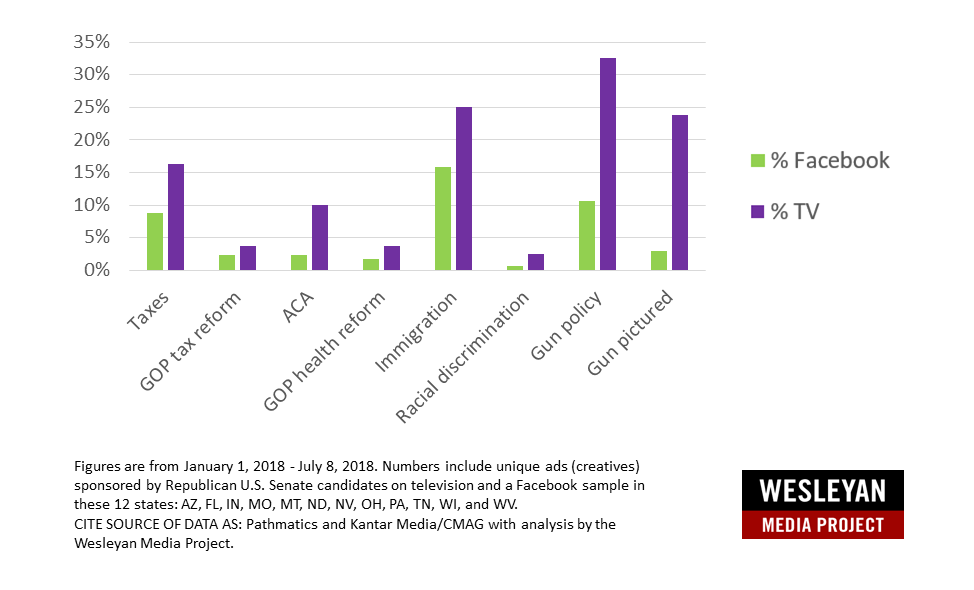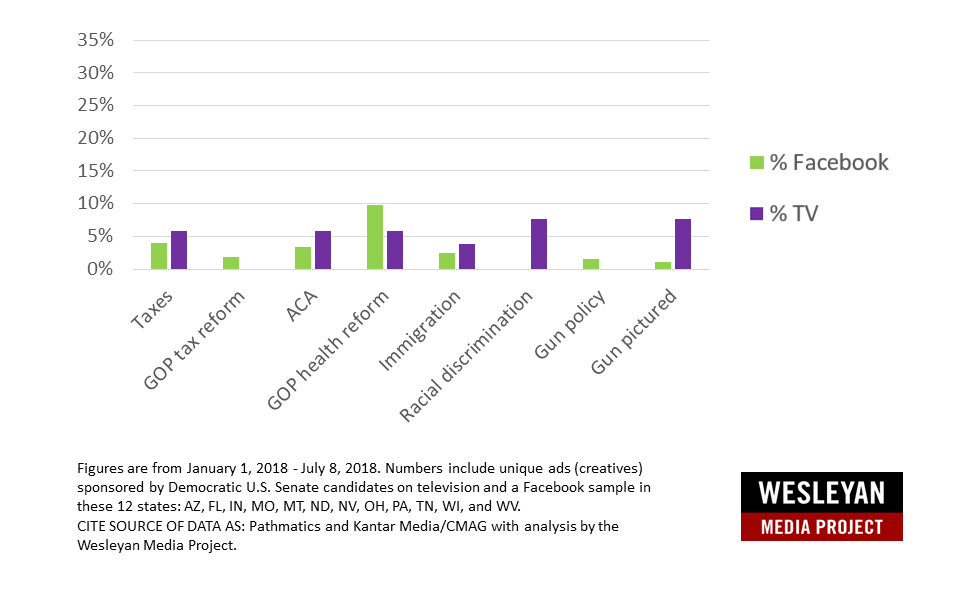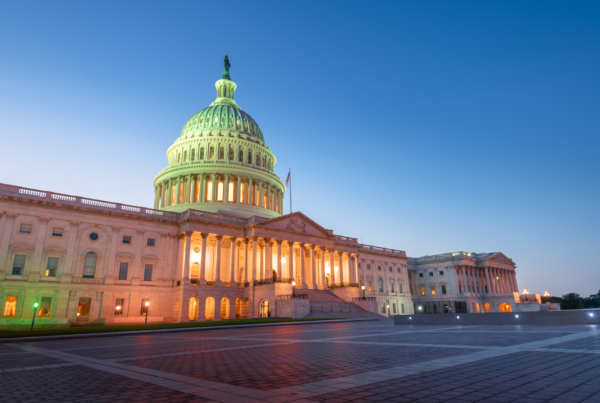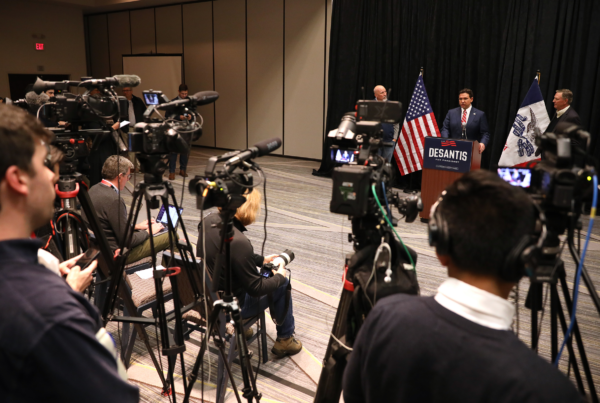But a Comparison of FB and TV Suggests the Emphasis from Senate Candidates is Different Across Platforms
![]()
![]()
(MIDDLETOWN, CT) August 1, 2018 – Mentions of Donald Trump are quite common in Facebook advertising from many Senate candidates, according to a new analysis. The Wesleyan Media Project is pleased to provide our first comparison (and we believe the first systematic comparison) of ad content on television with ad content on Facebook. The analysis focuses on unique ads posted or aired this year by several candidates running for U.S. Senate. Wesleyan Media Project staff analyzed Facebook creatives captured and reported by Pathmatics – a marketing intelligence company that tracks digital ad creatives, spend, and impressions across social, display, video, native, and mobile – and television creatives captured and reported by Kantar Media/CMAG. The analysis shows that television creatives are more likely to contain references to key policy issues, a finding that is likely driven by the many different purposes Facebook ads may be used for (e.g., to encourage fundraising and sign-ups in addition to persuasion, etc).
In this report, we analyze the content of creatives (unique ads) sponsored by 24 Senate candidates from 12 states (AZ, FL, IN, MO, MT, ND, NV, OH, PA, TN, WI, and WV) between January 1, 2018 and July 8, 2018, and run on Facebook or on television. Television airings are not equivalent to digital ad impressions, and so a focus on creatives (that is, the ads produced for distribution on each platform) makes the cross-platform comparison more equivalent.
The Facebook data include coding of 566 unique creatives found in the mobile newsfeeds of members of Pathmatics’ opt-in panel (see details in the about this report section), which is designed to be reflective of the diversity of active Facebook users; however, unlike the television ads, the Facebook ads are a sample. Our television data include 132 unique creatives, which constitute the universe of English-language ads aired on broadcast television since January 1 by the 24 candidates. In this report we discuss candidate-sponsored creatives; we do not discuss Facebook or television ads sponsored by political parties or by outside groups in support or opposition of the included candidates.
![]()
Trump Mentioned (Negatively) in A Third of Dem FB Creatives
Table 1 displays the percentage of Senate candidate ads on Facebook that mention Trump and other political figures. Our analysis shows that Trump was the most mentioned person—by a long shot. The table shows the number of unique ads that mentioned each political figure—along with the percentage of unique Democratic creatives and the percentage of unique Republican creatives that mentioned each person in a positive, negative and neutral light.
Trump was mentioned negatively in a third of Democratic ads (33.5 percent) and positively in over a quarter of Republican ads (28.4 percent)—and mentioned negatively in fewer than 1 percent of Republican ads.
![]()
Table 1: Mentions of Political Figures in Facebook Creatives by Select Senate Candidates
| Mentions | Dem pos | Dem neg | Dem neutral | Rep pos | Rep neg | Rep neutral |
|
|---|---|---|---|---|---|---|---|
| Donald Trump | 219 | 0.0% | 33.5% | 9.4% | 28.4% | 0.6% | 0.6% |
| Mitch McConnell | 76 | 0.0% | 15.9% | 3.3% | 0.0% | 0.0% | 0.0% |
| Charles Schumer | 11 | 0.0% | 0.0% | 0.0% | 0.0% | 6.5% | 0.0% |
| Barack Obama | 8 | 0.0% | 0.0% | 0.0% | 0.0% | 4.7% | 0.0% |
| Hillary Clinton | 4 | 0.0% | 0.0% | 0.0% | 0.0% | 2.4% | 0.0% |
| Robert Mueller | 4 | 1.0% | 0.0% | 0.0% | 0.0% | 0.0% | 0.0% |
| Paul Ryan | 3 | 0.0% | 0.8% | 0.0% | 0.0% | 0.0% | 0.0% |
| Nancy Pelosi | 3 | 0.0% | 0.0% | 0.0% | 0.0% | 1.8% | 0.0% |
| Figures are from January 1 through July 8, 2018. Numbers include a sample of unique Facebook ads sponsored by 24 different U.S. Senate candidates: Baldwin, Blackburn, Blankenship, Braun, Bredeson, Brown, Casey, Cramer, Donnelley, Fagg, Hawley, Heitkamp, Heller, Jenkins, Manchin, McCaskill, Morrisey, Nelson, Olszewski, Rokita, Rosen, Rosendale, Sinema and Tester. CITE SOURCE OF DATA AS: Pathmatics with analysis by the Wesleyan Media Project. |
|||||||
Senate majority leader Mitch McConnell was mentioned negatively in several Democratic ads (15.9 percent), but he earned not a single mention from Republicans. Though less frequently a target, Democratic Senate leader Charles Schumer was mentioned negatively in 6.5 percent of Republican ads but was unmentioned by Democrats. Perhaps unsurprisingly, Paul Ryan and Nancy Pelosi, who are leaders in the House, were rarely mentioned in Senate ads.
![]()
“With the exception of Trump, Senate candidates are not mentioning the leaders of their own party in a positive light on Facebook,” said Travis Ridout, co-director of the Wesleyan Media Project. “It seems that vilifying the other party’s leaders does more to excite the base to donate and participate online than talking about the leaders of one’s own party.”
![]()
Barack Obama was mentioned in 8 ads (mostly Republican), while Hillary Clinton, by and large, was no longer the center of attention, receiving just 4 mentions (all negative mentions from Republican candidates).
Negative Mentions of Obama, Clinton Common in Republican TV Creatives
In Senate candidate ads produced for television, by contrast, mentions of Obama and Hillary Clinton were much more common than on Facebook (Figure 1). Fully 30 percent of Republican ads (again, creatives not airings) mentioned Obama in a negative light on television, compared to under 5 percent of Facebook ads doing so. Similarly, 26 percent of Republican television ads mentioned Hillary Clinton negatively versus 2.4 percent of Facebook ads from Republican candidates. Nancy Pelosi was mentioned negatively in 5 percent of Republican television ads but in just 1.8 percent of Republican Facebook ads.
![]()
Figure 1: Negative Politician Mentions in Republican Senate Creatives by Medium
Table 2, in addition to showing which party’s candidates mentioned Obama, Clinton and Pelosi, also reveals that Trump is often mentioned positively by Republican candidates on TV. In fact, 42.5 percent of Republican ads on television featured a positive mention of the president. But these particular Democratic Senate candidates are much shyer about mentioning Trump on television than on Facebook. Although Democratic mentions of Trump are rare, the only mentions of the president by Democratic candidates were neutral or positive in tone. (Again it is important to reiterate that this comparison only includes select candidate-sponsored Senate creatives and ignores the House candidates, group and party-sponsored airings. There are negative mentions of Trump in pro-Democratic advertising on television in the full universe discussed here.)
![]()
Table 2: Mentions of Political Figures in Television Creatives by Select Senate Candidates
| Mentions | Dem pos | Dem neg | Dem neutral | Rep pos | Rep neg | Rep neutral |
|
|---|---|---|---|---|---|---|---|
| Donald Trump | 40 | 3.8% | 0.0% | 7.7% | 42.5% | 0.0% | 0.0% |
| Barack Obama | 24 | 0.0% | 0.0% | 0.0% | 0.0% | 30.0% | 0.0% |
| Hillary Clinton | 21 | 0.0% | 0.0% | 0.0% | 0.0% | 26.3% | 0.0% |
| Mitch McConnell | 5 | 0.0% | 1.9% | 0.0% | 0.0% | 5.0% | 0.0% |
| Nancy Pelosi | 4 | 0.0% | 0.0% | 0.0% | 0.0% | 5.0% | 0.0% |
| Charles Schumer | 2 | 0.0% | 0.0% | 0.0% | 0.0% | 2.5% | 0.0% |
| Robert Mueller | 1 | 0.0% | 0.0% | 0.0% | 0.0% | 1.3% | 0.0% |
| Paul Ryan | 0 | 0.0% | 0.0% | 0.0% | 0.0% | 0.0% | 0.0% |
| Figures are from January 1 through July 8, 2018. Numbers include a sample of unique Facebook ads sponsored by 24 different U.S. Senate candidates: Baldwin, Blackburn, Blankenship, Braun, Bredeson, Brown, Casey, Cramer, Donnelley, Fagg, Hawley, Heitkamp, Heller, Jenkins, Manchin, McCaskill, Morrisey, Nelson, Olszewski, Rokita, Rosen, Rosendale, Sinema and Tester. CITE SOURCE OF DATA AS: Kantar/CMAG with analysis by the Wesleyan Media Project. |
|||||||
![]()
Issue Mentions in Sample of Senate Facebook Creatives
Table 3 displays a variety of “hot button” issues and how frequently they were mentioned in candidates’ paid ads on Facebook. As with the mentions of politicians, the numbers are based on a sample of unique ads sponsored by Senate candidates between January 1, 2018, and July 8, 2018.
The Republican attempts at health care reform were mentioned the most among the issues tracked, appearing in 7.4 percent of the Facebook ads, but almost all of those mentions came on the Democratic side, with just 2 percent of Republican ads mentioning the attempts to pass a health care bill. Immigration was mentioned in 6.5 percent of ads, largely by Republicans. In fact, 15.9 percent of Republican ads on Facebook mentioned immigration compared to 2.5 percent of Democratic ads. Taxation was mentioned in 5.5 percent of ads, with Republicans devoting more attention than Democrats to the issue. Gun policy was mentioned lopsidedly by Republicans, appearing in 10.6 percent of their ads, as opposed to 1.5 percent of Democratic ads. None of the ads for the Senate candidates in the sample we tracked referenced the Parkland shooting or DACA.
![]()
Table 3: Key Policy Mentions in Facebook Creatives by Select Senate Candidates
| Total Mentions | % total ads | % Dem ads | % Rep ads | |
|---|---|---|---|---|
| GOP health reform | 42 | 7.4% | 9.8% | 1.8% |
| Immigration | 37 | 6.5% | 2.5% | 15.9% |
| Taxes | 31 | 5.5% | 4.0% | 8.8% |
| Gun policy | 24 | 4.2% | 1.5% | 10.6% |
| ACA | 17 | 3.0% | 3.3% | 2.4% |
| Gender discrimination | 15 | 2.7% | 3.5% | 0.6% |
| GOP tax reform | 11 | 1.9% | 1.8% | 2.4% |
| Gun pictured | 9 | 1.6% | 1.0% | 2.9% |
| Racial discrimination | 1 | 0.2% | 0.0% | 0.6% |
| Parkland shooting | 0 | 0.0% | 0.0% | 0.0% |
| DACA | 0 | 0.0% | 0.0% | 0.0% |
| Figures are from January 1 through July 8, 2018. Numbers include a sample of unique Facebook ads sponsored by 24 different U.S. Senate candidates: Baldwin, Blackburn, Blankenship, Braun, Bredeson, Brown, Casey, Cramer, Donnelley, Fagg, Hawley, Heitkamp, Heller, Jenkins, Manchin, McCaskill, Morrisey, Nelson, Olszewski, Rokita, Rosen, Rosendale, Sinema and Tester. CITE SOURCE OF DATA AS: Pathmatics with analysis by the Wesleyan Media Project. |
||||
![]()
Gun Policy, Immigration Major Topics in the Comparison Set of Television Creatives
In television ads produced for the same set of Senate candidates, the most mentioned issue was gun policy, which appears in one in five ads (Table 4). Almost one-third of Republican television creatives mentioned the issue, while Democratic candidates ignored it. Guns were also commonly pictured in ads, appearing in 7.7 percent of Democratic candidate ads and 23.8 percent of Republican candidate ads.
![]()
Table 4: Key Policy Mentions in Television Creatives by Select Senate Candidates
| Issue | Total Mentions | % total ads | % TV Dem ads | % TV Rep ads |
|---|---|---|---|---|
| Gun policy | 26 | 19.7% | 0.0% | 32.5% |
| Gun pictured | 23 | 17.4% | 7.7% | 23.8% |
| Immigration | 22 | 16.7% | 3.8% | 25.0% |
| Taxes | 16 | 12.1% | 5.8% | 16.3% |
| ACA | 11 | 8.3% | 5.8% | 10.0% |
| GOP health reform | 6 | 4.5% | 5.8% | 3.8% |
| Racial discrimination | 6 | 4.5% | 7.7% | 2.5% |
| GOP tax reform | 3 | 2.3% | 0.0% | 3.8% |
| Domestic violence | 1 | 0.8% | 0.0% | 1.0% |
| DACA | 0 | 0.0% | 0.0% | 0.0% |
| Parkland shooting | 0 | 0.0% | 0.0% | 0.0% |
| Figures are from January 1 through July 8, 2018 . Numbers include unique television ads sponsored by 24 different U.S. Senate candidates: Baldwin, Blackburn, Blankenship, Braun, Bredeson, Brown, Casey, Cramer, Donnelley, Fagg, Hawley, Heitkamp, Heller, Jenkins, Manchin, McCaskill, Morrisey, Nelson, Olszewski, Rokita, Rosen, Rosendale, Sinema and Tester. CITE SOURCE OF DATA AS: Kantar/CMAG with analysis by the Wesleyan Media Project. |
||||
Immigration was another hot topic on television, mentioned in 16.7 percent of unique ads—mainly on the Republican side. Fully one-fourth of Republicans’ television ads mentioned immigration. Only about 4 percent of Democratic television creatives did.
![]()
“Guns and immigration are topics that seem to make the Republican base pay attention, and so it’s not surprising that they appeared in a lot of candidate’s ads during the primary phase of the campaign,” said Erika Franklin Fowler, co-director of the Wesleyan Media Project. “It will be interesting to see if these hot-button issues are mentioned at the same rate in the general election or whether Republican candidates will turn to issues that might be of more concern to independent voters.”
![]()
Taxes and the Affordable Care Act were also mentioned in over 5 percent of ads, but several issues, including the Parkland shooting and DACA were also not mentioned on television by the 24 Senate candidates whose advertising we tracked.
Figures 2 and 3 compare the relative focus of creatives produced for the 24 Senate candidates in the Facebook sample and on television for Democrats versus Republicans.
![]()
Figure 2: Key Policy Mentions in Republican Senate Creatives by Medium
![]()
Figure 3: Key Policy Mentions in Democratic Senate Creatives by Medium
About This Report
Data reported here from Kantar Media/CMAG do not cover local cable buys, only broadcast television, national network and national cable buys. Data reported here on the Pathmatics sample come from the paid advertising in the mobile Facebook newsfeeds of their opt-in panel, which tracks paid advertising from hundreds of thousands of users who reflect the diversity of active Facebook users. All comparisons in this report are at the creative (unique ad) level as opposed to ad airings or impressions. Television airings are not equivalent to digital ad impressions, and so a focus on creatives (that is, the ads produced for distribution on each platform) makes the cross-platform comparison more equivalent. This report, therefore, can speak to the issues and people referenced in the advertising produced and distributed on each platform, but not necessarily the relative frequency with which the issues and people appear.
The Wesleyan Media Project (WMP) provides real-time tracking and analysis of political advertising in an effort to increase transparency in elections. Housed in Wesleyan’s Quantitative Analysis Center – part of the Allbritton Center for the Study of Public Life – the Wesleyan Media Project is the successor to the Wisconsin Advertising Project, which disbanded in 2009. It is directed by Erika Franklin Fowler, associate professor of government at Wesleyan University, Michael M. Franz, professor of government at Bowdoin College and Travis N. Ridout, professor of political science at Washington State University. WMP staff include Laura Baum (Project Manager), Dolly Haddad (Project Coordinator) and Matthew Motta (Research Associate).
The Wesleyan Media Project is supported by Wesleyan University. Data are provided by Kantar Media/CMAG with analysis by the Wesleyan Media Project. WMP is partnering again this year with the Center for Responsive Politics, to provide added information on outside group disclosure.
Periodic releases of data will be posted on the project’s website and dispersed via Twitter @wesmediaproject. To be added to our email update list, click here.
For more information contact:
Lauren Rubenstein, lrubenstein@wesleyan.edu, (860) 685-3813
About Wesleyan University
Wesleyan University, in Middletown, Conn., is known for the excellence of its academic and co-curricular programs. With more than 2,900 undergraduates and 200 graduate students, Wesleyan is dedicated to providing a liberal arts education characterized by boldness, rigor and practical idealism. For more, visit wesleyan.edu.







